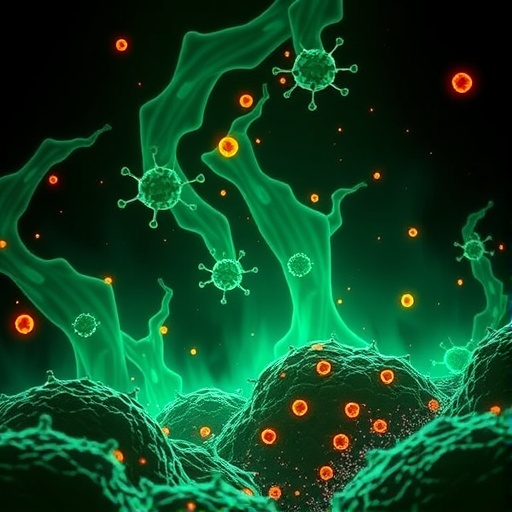In the realm of cancer biology, the process of anoikis emerges as a pivotal mechanism for maintaining tissue homeostasis and suppressing metastasis. Anoikis, a form of programmed cell death induced by detachment from the extracellular matrix (ECM), plays a fundamental role in eliminating cells that have lost their appropriate microenvironment. In normal epithelial tissues, cellular detachment triggers epithelial extrusion—a highly regulated mechanism where cells are expelled to maintain tissue integrity and function. These extruded cells then undergo anoikis, ensuring they do not survive in inappropriate locations. However, an ominous deviation unfolds in metastatic cancer cells. Unlike their normal counterparts, these malignant cells develop anoikis resistance, enabling survival despite detachment from the primary ECM, thus facilitating their ability to invade circulation, disseminate, and establish secondary tumors.
Over the past three decades, research into anoikis and its intersection with cancer progression has uncovered intricate molecular crosstalk governing cell survival, motility, and apoptosis. Early studies illuminated the role of integrin-mediated signaling pathways, which convey attachment status to intracellular apoptotic machinery. Integrins, transmembrane receptors linking ECM to cytoskeleton, serve as sentinels for adhesion integrity. Loss of integrin engagement triggers apoptotic cascades, notably through modulation of focal adhesion kinase (FAK), Src family kinases, and downstream effectors like the pro-apoptotic BCL-2 family proteins. However, metastatic cells subvert these pathways, often by altering integrin expression profiles or activating compensatory survival signals. This evasion from anoikis is a hallmark of their malignancy and metastatic potential.
Recent advancements transcend earlier paradigms by probing deeper into the nuanced relationship between the cytoskeleton and signaling networks in the orchestration of anoikis versus survival. The cytoskeleton, comprising actin filaments, microtubules, and intermediate filaments, is not simply a structural scaffold but an active participant in signal transduction and cellular stress responses. Mechanical cues and cytoskeletal dynamics modulate signaling nodes such as Rho GTPases, YAP/TAZ transcriptional regulators, and focal adhesion complexes. Metastatic cells exploit these pathways to reprogram adhesion-independent survival and to modulate the epithelial-to-mesenchymal transition (EMT), which confers mobility and plasticity. Disentangling the cytoskeletal signaling interface has provided critical insights into how cancer cells resist anoikis and sustain malignant behavior.
Another frontier lies in dissecting epithelial extrusion during normal tissue homeostasis compared to its deregulation in cancer. In healthy epithelia, extrusion is a spatially and temporally orchestrated event involving coordinated contraction by actomyosin rings and dynamic rearrangement of adhesion molecules. This process ensures removal of damaged or surplus cells while preserving barrier function. Contrastingly, in cancerous tissues, extrusion is often compromised or hijacked to favor tumor expansion and invasion. Aberrant extrusion might allow tumor cells to delaminate without initiating anoikis, subsequently supporting their dissemination. The upstream signals dictating extrusion programming, including the roles of neighboring cells, mechanical forces, and biochemical factors, remain an active area of investigation with profound implications for metastasis prevention.
Translational regulation has emerged as a pivotal yet underexplored dimension of anoikis biology. The control of mRNA translation in response to detachment stress governs the synthesis of key proteins involved in survival and apoptosis. Cancer cells frequently remodel their translational machinery, employing mechanisms such as internal ribosome entry sites (IRES), selective mRNA stabilization, and modulation of translation initiation factors. This allows adaptive protein synthesis profiles that enable evasion of anoikis despite ECM detachment. Recent studies have begun to unravel how translational regulators modulate the expression of survival proteins like BCL-XL, c-FLIP, and various kinases, offering fresh therapeutic targets to reinstate anoikis sensitivity in metastatic cells.
Further complicating the landscape, the interactions between tumor cells and blood components during hematogenous dissemination significantly influence anoikis resistance and metastatic success. Circulating tumor cells (CTCs) encounter a hostile milieu marked by shear stress, immune surveillance, and absence of ECM support. Yet, these cells often co-opt platelets and leukocytes to form protective emboli, which shield them from immune killing and mechanical stress. Platelet cloaking can activate anti-apoptotic signaling pathways within tumor cells and promote adhesion to distant vascular niches. Understanding the molecular dialogues between CTCs and blood cells not only clarifies anoikis resistance mechanisms but also highlights novel points for therapeutic intervention to disrupt metastasis.
Collectively, these recent discoveries converge to reshape our understanding of how tumor cells circumvent anoikis—a critical barrier against metastatic progression. Incorporating knowledge of cytoskeleton-signaling interfaces clarifies how mechanical and biochemical cues integrate to govern cell fate. Elucidating the dichotomy between normal and cancerous epithelial extrusion reveals vulnerabilities in tissue organization that cancer exploits. Decoding the translational control of apoptosis-related proteins opens avenues for targeted reversal of anoikis resistance. Moreover, appreciating the complex interplay between tumor cells and blood cells during circulation spotlights the multifaceted nature of metastasis.
Future research directions beckon to address unanswered questions and to develop more effective anti-metastatic therapies. Advancing live-cell imaging and single-cell transcriptomics holds promise for mapping the dynamic processes of extrusion and survival in real-time and in heterogeneous tumor environments. Therapeutic strategies aimed at disrupting cytoskeletal remodeling, reinstituting proper extrusion programming, or targeting translational regulators could restore anoikis sensitivity. Furthermore, interferencing with tumor cell-platelet interactions may reduce metastatic seeding, complementing existing treatments.
In sum, the evolving landscape of anoikis research unfolds a complex network of cellular, molecular, and biomechanical processes essential for normal epithelial health but subverted in cancer. This body of knowledge not only enriches tumor biology but also fuels innovative approaches to thwart the spread of cancer. As the clinical imperative to target metastasis grows, illuminating the enigmatic mechanisms of anoikis resistance stands as a beacon toward improved prognosis and patient survival.
Subject of Research: Anoikis resistance mechanisms in cancer metastasis
Article Title: Anoikis resistance and cancer
Article References: Frisch, S.M., Hu, G. Anoikis resistance and cancer. BMC Cancer 25, 1764 (2025). https://doi.org/10.1186/s12885-025-15178-6
Image Credits: Scienmag.com
DOI: 14 November 2025
Keywords: anoikis, cancer metastasis, epithelial extrusion, cytoskeleton, translational regulation, tumor cell-blood cell interactions, integrin signaling, epithelial-mesenchymal transition




